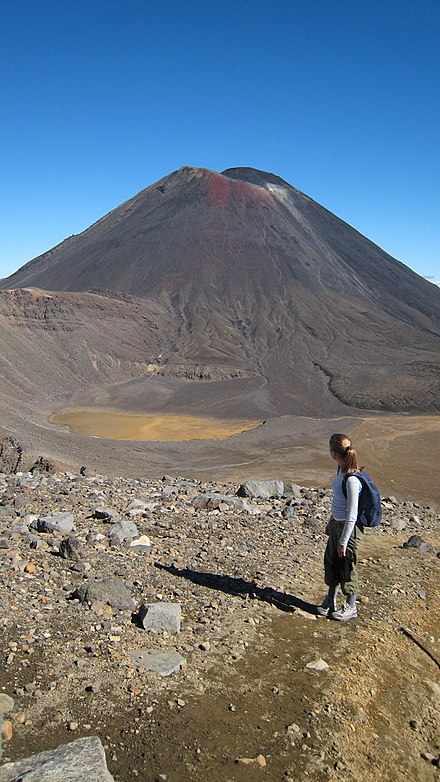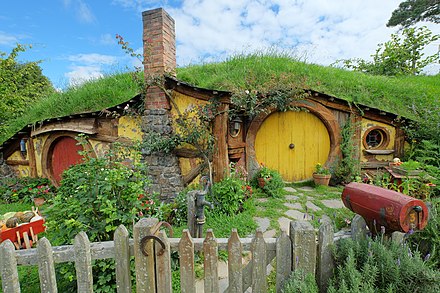Lord of the Rings tourism
Lord of the Rings tourism
The Lord of the Rings (LotR) is a film series in the high fantasy or epic fantasy genre, based on novels by J. R. R. Tolkien, including The Hobbit in 1937 and The Lord of the Rings, published in 3 volumes in the 1950s, set in a fictional world known as Middle-earth. The film series was shot in New Zealand, and the sets are today among the most visited tourist attractions of the country.
Understand
 While Tolkien's novels codified the epic fantasy genre, and assembled an unprecedented community of fans, its live-action adaptation took many decades to develop. An animated film series made in the 1970s was met with lukewarm reviews, and fans expressed skepticism when New Zealand director Peter Jackson was announced to direct a Lord of the Rings film trilogy for release in 2001 to 2003.
While Tolkien's novels codified the epic fantasy genre, and assembled an unprecedented community of fans, its live-action adaptation took many decades to develop. An animated film series made in the 1970s was met with lukewarm reviews, and fans expressed skepticism when New Zealand director Peter Jackson was announced to direct a Lord of the Rings film trilogy for release in 2001 to 2003.
The total budget of Jackson's trilogy was US$280 million. The films were praised by critics and fans, combining to win a total of 17 Academy Awards out of 30 they were nominated for. The final film in the series, The Return of the King, won all 11 Academy Awards it was nominated for, including Best Picture, making it tied with Ben-Hur (1959) and Titanic (1997) for the greatest number of Academy Awards won by a single film.
In 2012 to 2014, Peter Jackson moved backwards in the story's chronology and adapted The Hobbit novel into a trilogy of films. While not as critically successful, with only the first film winning a single honorary Academy Award, the films were a box office success, outgrossing the Lord of the Rings trilogy.
The works have been adapted to several media, including video games, board games, and inspired later works, as well as live-action roleplaying.
The film franchise continues to maintain a website with information about Blu-ray and DVD re-releases and the like. The publisher of the books also maintains its own website covering The Lord of the Rings, as well as other works by Tolkien.
Prepare
The Hobbit is the most accessible of the books, and a recommended first read, followed by the novel trilogy, and the original film trilogy (which would be a great introduction for a visit to New Zealand). The Hobbit films and other material could be saved for later.
See
Studios
All six films were produced at Stone Street Studios in the city of Wellington, New Zealand, which is still an active film studio and is generally not open to the public. However, most of the props and sets were designed and made in the nearby Weta Workshop, which does host public tours that can be booked through the company website.
- Weta Workshop, 21 Camperdown Road, Miramar, Wellington (corner of Camperdown Road & Weka Street, #2 bus from Railway Station or Courtenay Place), -41.3059°, 174.8236°, +64 4 909 4000. Tours $25-145 2017-03-21
- Weta Cave, 1 Weka Street, Miramar, Wellington (corner of Camperdown Road, #2 bus from Railway Station or Courtenay Place), -41.3064°, 174.8242°, +64 4 909 4100, bookings@wetaworkshop.co.nz. Daily 09:00-17:30. Weta's mini museum and souvenir shop in which you can purchase The Lord of the Rings memorabilia. Behind-the-scenes documentary film every 30 minutes. Photography allowed everywhere. Free entry 2017-03-21
Filming locations

 The Lord of the Rings was filmed entirely in New Zealand, making use of the country's famed stunning landscapes as a backdrop for many scenes. It's due to this and the sometimes pretty long landscape shots that some jokingly call the films "one giant tourism advertisement for New Zealand".
The Lord of the Rings was filmed entirely in New Zealand, making use of the country's famed stunning landscapes as a backdrop for many scenes. It's due to this and the sometimes pretty long landscape shots that some jokingly call the films "one giant tourism advertisement for New Zealand".
Waikato
Matamata is where the Shire and Hobbiton scenes were filmed.
- Hobbiton Movie Set Tours, 501 Buckland Rd, Hinuera (14 km from Matamata. Free pick-up from Matamata i-Site), -37.8575°, 175.679722°, +64 7 888 1505. Daily 08:30-16:30 (September to April); daily 08:30-15:30 (May to August). Tour the film set used for the Shire in The Lord of the Rings and The Hobbit film trilogies. Adult $84, youth (9-16) $42, children (0-8) free with paying adult 2018-04-23
Central North Island
- Mount Ngauruhoe, Tongariro National Park, -39.156944°, 175.631944°. The stratovolcano was the stand-in for Mount Doom (with some help from CGI). The summit itself is now off-limits, but there are close-up vantage points of Ngauruhoe from the popular Tongariro Alpine Crossing walk. 2017-03-06
Greater Wellington
Wellington is the capital of New Zealand. One of the most picturesque cities in the world and where the production of the trilogy was centred in. Much of the close-up shots were filmed in locations throughout the city and in the neighbouring Hutt Valley. The director of the films, Peter Jackson, was born and continues to reside in Wellington.
-
Harcourt Park (Isengard), Brown Owl, Upper Hutt, -41.101711°, 175.095007°. A park located in the city of Upper Hutt, where some of the Isengard scenes, such as the famous scene of Gandalf riding on the road to Isengard Tower, were filmed. None of the sets remain as the filmmakers were required to return the park to its original condition once filming was done, and the tower itself was never actually built but was later digitally added to the scene. Nevertheless, the park is still a rather pretty one and a nice place to relax and have a picnic. Free
-
Kaitoke Regional Park (Rivendell), Waterworks Road, Kaitoke (off SH 2, 16 km north of Upper Hutt), -41.0571°, 175.1932°. The Rivendell set location, with a replica of the Elvish Archway, is a short walk from the Pakuratahi Forks carpark. 2017-03-06
-
Putangirua Pinnacles, Cape Palliser Rd, South Wairarapa (45 km south of Martinborough, on the way to Cape Palliser), -41.4507°, 175.222°. Formed by badlands erosion, the pinnacles were the location of the Paths of the Dead sequence from The Return of the King. They can be viewed from a lookout which is a two-hour return walk from the carpark and DOC campsite.
-
Mount Victoria, Lookout Rd, Hataitai, Wellington (#20 bus from Courtenay Place), -41.2984°, 174.786°. A hill located within the city of Wellington. A park on the hill was used to film the scenes in which the four hobbits were being chased by the Ringwraiths in the forest in the first movie, The Fellowship of the Ring. Free
-
Dry Creek Quarry, Haywards Hill Rd (SH 58), Haywards, Lower Hutt, -41.16639°, 174.9531°. Where the sets for Helm's Deep and Minas Tirith were built. None of the sets remain, and the location is still a working quarry that is generally not open to the public, though it can be viewed from the outside.
Nelson
Just across the sea from Wellington, and home to the workshop where many of the props were made. Several filming sites are also located in the surrounding countryside.
Canterbury
The Mackenzie Country around Twizel 📍 stood in for Pelennor Fields.
Queenstown-Lakes
Many scenes were filmed in the areas surrounding the town of Glenorchy 📍 near Queenstown 📍. This area is well known as one of the most scenic, though remote areas of New Zealand, and some filming sites are located several hours' drive from civilisation on gravel roads.
- Paradise, 1771 Paradise Road, Glenorchy, -44.724695°, 168.363148°, +64 3 442 9956. A forested area near Glenorchy where the scene in which Boromir was killed by the orcs, and where Merry and Pippin were kidnapped, was filmed. free
Fiordland National Park
Locations connected to Tolkien
There are also several locations connected to the author of the books, J. R. R. Tolkien, that have been popular with fans of the books for a long time before the films were even made.
- Bloemfontein, South Africa - Where Tolkien was born to English parents.
- Birmingham, England - The city where Tolkien grew up in after his father's death when he was 3 years old.
- Oxford, England - Tolkien was a student, and later a professor at the University of Oxford, during which he wrote both The Hobbit and The Lord of the Rings. It was also here that he formed a long-lasting friendship with C. S. Lewis, the author of The Chronicles of Narnia, another critically acclaimed fantasy novel series. Both were members of a more or less formalized circle and discussion group of fellow authors called the "Inklings", which met regularly at a pub known as The Eagle and Child.
Learn
Tolkien was a professor of linguistics at the University of Oxford who famously argued with his translators on how certain things should be translated into their native languages, and constructed many fictional languages for the different races of his fictional world. These languages were subsequently expanded on by linguist David Salo for the films, and featured prominently in them. Among the most thoroughly fleshed out and popular of these languages are the Elvish languages of Sindarin and Quenya, spoken by the elves of Rivendell and Lothlórien respectively. Other fictional languages featured in the series included the Dwarvish language of Khuzdul, as well as the Black Speech of Mordor. The popularity of Tolkien's works has led many dedicated fans to attempt to learn these languages. Several Tolkien societies have provided both online resources and actual classes for those interested in learning how to speak the languages, and some of the more passionate ones even conduct some of their society meetings in these languages.